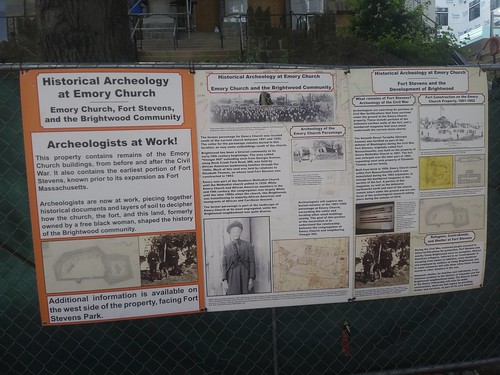National Historic Preservation Month: Archaeology and Fort Stevens, DC
Probably the biggest hole in my knowledge about historic preservation is archaeology. Just like how there is a break in understanding between what we might call "high" and "low" preservation -- "high" being related to high art and people or events of lasting historical significance vs. "low" or vernacular and social-cultural-economic history as represented by the creation of historic districts at the neighborhood scale, archaeology is the same--between pre-history and social-economic-cultural history as exhibited by "digging up disturbed earth," from slave quarters to old building sites.
Many places require that archaeological digs occur in advance of new construction, and this can be a requirement of federal undertakings.
This road is almost 1,800 years old and sits on top of an earlier road dating almost 600 years older.
In older countries, this is especially important and it is common for digs because of new development in places like Greece, Turkey, and the UK to uncover incredible history.
For example when building the subway in Thessaloniki, they found part of the original road from Rome, dating back more than 1,500 years ("Subway work unearths ancient marble road in Greece," NBC News).
The Emory Beacon of Light Church is building affordable housing on its site, around the church. The church pre-dates the creation of Fort Stevens, a Civil War era fort, where President Lincoln actually came under fire while watching Union troops repel a Confederate assault.
 They did archaeological study of the site (which continues), and unusually, they have posted information about what they found on the promotional banners hung on the site's construction fencing.
They did archaeological study of the site (which continues), and unusually, they have posted information about what they found on the promotional banners hung on the site's construction fencing.Since an ongoing element of the historic preservation items this month have been about communication, like the one about Downtown Phoenix sending out release about distinctive historic buildings in their downtown, this caught my eye because it's very rare for such findings to be communicated so directly on site.
This type of public communication requirement should be added to the process.
======
I forgot to mention that the City of Alexandria has been in the news, as waterfront construction has unearthed ships that were sunken as part of land reclamation efforts in past centuries ("Public can view centuries-old ships uncovered in Alexandria," WTOP).
-- Society for Commercial Archeology
-- Society for Industrial Archeology
-- The annual conference for SIA is May 31st to June 3rd in Richmond
-- "Meet the latest tourism destinations: abandoned factories," Washington Post
-- Palisades Museum of Prehistory - Washington, D.C.
-- Archeology Program, National Park Service
Labels: historic preservation




1 Comments:
Alexandria has archaeology staff and requirements for development applications.
Post a Comment
<< Home